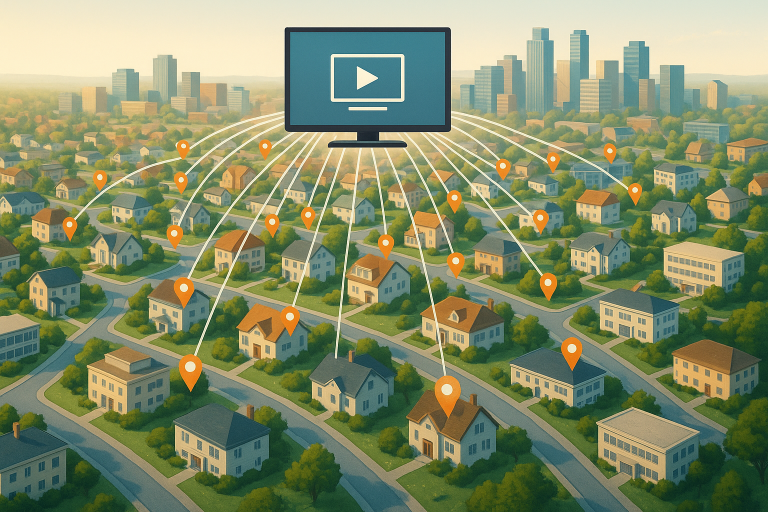The Power of NarrowCasting
The Smarter Way to Build Business & grow your audience

Don’t try to reach everyone. Try to reach the right one.
For decades, marketing and outreach — whether in business or politics — have focused on reaching the broadest audience possible with a universal message that could have the largest appeal.
Broadcast television, broadcast radio, and print media have dominated this arena, because they offer advertisers audiences to scale. As former broadcast journalists, we understand. But the media landscape is changing, and the benefit of scale alone doesn’t always mean success.
Reaching everyone often means resonating with no one.
Take the Super Bowl, for example. It’s the ultimate broadcast event with more than 100 million viewers and hundreds of millions of dollars spent for a 30-second ad. Advertisers hope that casting a wide net to a large audience will catch enough eyes to gain some level of marketshare, but the real question is whether the audience they’re talking to is the audience they’re trying to reach.

With today’s target-market technology, there are better, more strategic ways to invest marketing and outreach dollars: narrowcasting.
This data-driven approach to marketing and outreach, at its core, is not about messaging seen by the masses. It’s about messaging seen by the people who matter most—the ideal customers, the most likely buyers, the most valuable constituents who are primed for a very specific message.
It’s more measurable, more cost-effective, and more actionable than ever.
What Businesses & Organizations Need to Know About Narrowcasting
With precision-targeted outreach, businesses and organizations can now craft tailored content for defined groups—based on data like demographics, interests, geography, or behavior.
It’s not just marketing. It’s messaging engineered for action!
The applications across business and politics are numerous. Take, for example, a regional outdoor equipment brand looking to grow its marketshare. Rather than buying television ads across multiple stations and networks hoping to catch a few interested anglers, narrowcasting can digitally target audiences who recently visited lakes, searched for kayak gear, or followed a fishing trail app—delivering a specifically targeted message to an already-primed audience when and where it matters.
Or take an organization looking to impact legislation. Rather than solely focusing on broadcast and cable ad buys that are limited in reach and audience among a vast choice of media outlets, narrowcasting targets constituents who are more likely to vote, have certain political affiliations, are in particular age groups, or who have certain behavioral/buying tendencies with call-to-action messaging that will not only engage them directly, but motivate them to contact elected officials.
This kind of micro-targeting uses platforms like programmatic display ads, connected TV, paid social, and geo-fencing to engage potential customers at key moments in their journey.
Performance That Delivers ROI
On average, digital display ads have a click-through rate of about 0.2%. But with audience-specific targeting and well-matched messaging, companies and organizations we’ve worked with are seeing results that are 1.5 to 2.5 times better. That translates into more engagement, more leads, and more conversions—without the waste.
And narrowcasting builds something deeper: trust. When a message speaks to a need or pain point a targeted audience actually has, it’s more than just noise—it’s value. It positions brands and messaging not just as products or services, but as a solution.
Turning Strategy into Action
How can business and organizational leaders bring narrowcasting into their marketing strategy?
1. Start with segmentation
Define who the best customers and constituents are and then break them into high-priority subgroups. It’s not just looking at age or gender. It’s also about lifestyle, buying behavior, online activity, and interests.
2. Refine your messaging
Speak directly to each segment. What motivates them? What frustrates them? Tailored messages always outperform generic ones.
3. Use the right tools
Platforms like Facebook, Google, programmatic display ads, and even direct SMS allow precise delivery to segmented audiences.
4. Don’t go digital-only
Reinforce your narrow cast efforts with offline engagement—events, mailers, partnerships, or sponsorships. The more touchpoints you create, the more your brand becomes part of your audience’s world.
5. Track and iterate.
Digital narrow casting gives you data in real time. Use it. See what’s working, shift what’s not, and build smarter every quarter.
Why It Works
Narrowcasting gives businesses and organizations what they need most: efficiency. It cuts through the noise, reduces wasted spend, and focuses messaging where it can do the most good and reach the right audience. It helps build stronger brand identity among not just any people, but the right people!
In a marketplace where attention is scarce and competition is fierce, the businesses and organizations that win are the ones that know exactly who they’re talking to…and say exactly what that audience needs to hear.
Don’t broadcast. Narrowcast. Your next audience is already listening.
Let’s Talk
Want to better understand how narrowcasting can help you reach your customers or constituents? Fill this out and let’s talk!

